Biological sensory surfaces as a new step in the evolution of gadgets

A telegraph station of the beginning of the 20th century and a modern smartphone - what do they have in common?
The main drawback of modern smartphones lies in the way information is transmitted. A hundred years ago, in order to read a message, it was necessary to go to the telegraph. Thirty years ago - answer the call by pressing one button. Get your phone now and ask yourself: how much time does it take to get the necessary information? Entering the password, launching the application, scrolling through the tape, reading the post with an eye on the falling battery charge. Information, we certainly have become richer, but for the information you have to pay the most expensive - time.
The person is trying to find new ways to get information. “Smart watches”, “smart cases”, headsets, Google Glass, SIRI, augmented reality change our ways of receiving and perceiving data. These first test devices will be followed by radical changes, the essence of which does not boil down to replacing one gadget with another. Only by removing the "intermediaries" are we really influenced by time savings.
')
In the bottom line, “smart accessories” look like a transitional stage of evolution, to replace which the real future is already knocking with the output of information on human skin, the transfer of data on bio-currents and the body-smartphone, which is not discharged in a day.
Let's see how it will be.

The perfect phone for Bender-bearer.
Let's start with the fact that a smartphone made of leather is rather a concept in which only the body is completely made of leather. Filling of a flexible display and flexible battery will allow the smartphone to withstand a certain load when bent, but no more. Talk to the author of the concept of a smartphone made from human skin, and he will take you for a crazy sadist. But there is no need to wrap the smartphone in the skin, again to step on the primitive rake of a complex scheme of obtaining information, when the smartphone itself can be applied to the skin. In scientific laboratories for many years they have been trying to make "electronic skin" - flexible, sturdy, stuffed with sensors, which will become the mainstream of future smartphones, without noticing that there is a natural universal analogue on Earth long ago.

Biohacker and bododiodifier Tim Cannon has radically embedded Circadia 1.0 in his hand, with which he is trying to control the systems of the smart home.
Another crazy idea is to embed a smartphone in the human body. Implants operating on wireless charging offer truly revolutionary capabilities, but they generate many new, potentially dangerous problems. A device inside the body can cause irreparable harm in case of failure. Hackers can access your implants. The consequences of this crime are well enough covered in cyberpunk literature (short: nothing good is waiting for you).
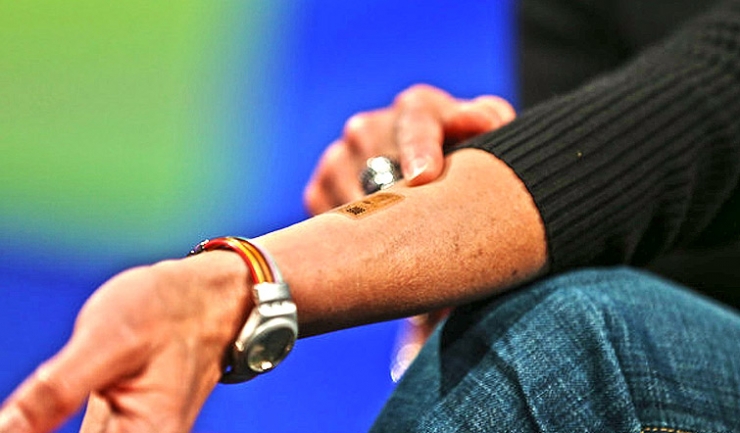
Can human skin become something like a smartphone display? We receive information about the world through many communication channels: taste, tactile sensations, temperature, vibration, body position, pain, and so on. Little of this list can convey a soulless piece of plastic. At the same time, skin is a terrific source of reception and transmission of information. Sensations that we experience with skin appear due to neurons collecting tactile information. An extensive neuron network not only senses objects, but also processes their geometric data.
Approximately the same number of sensory receptors is located on the skin as on the retina of the eye (they are only distributed over the entire area). Touching to something, we not only feel the touch itself, but also receive information about the shape of the object of contact, intensity, temperature, etc. The phrase “Caution, hot!” Is processed by the brain longer than the information from a finger pressed to a hot plate.
Our sensory senses begin to be processed by the peripheral neurons of the skin even before the signals reach the brain, where they are further processed ( Source ). Well, when we start to perceive information faster than it enters the brain, this is really great, isn't it? Faster than answer the phone ...
Nota Bene . There is a certain irony in the fact that the bacteria of human skin and the smartphone almost do not differ in their composition: 82% of the human microflora - these are streptococci, staphylococci and corynebacteria - are found on the smartphone screen.
Electronic tattoo
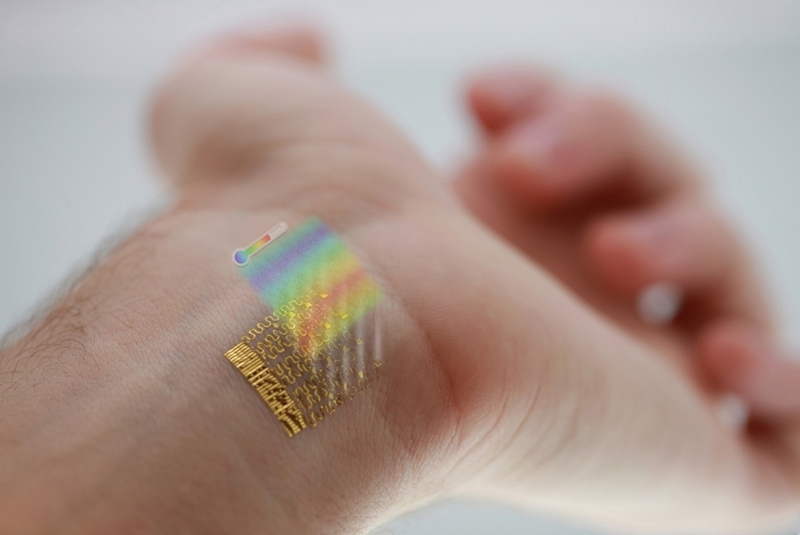
"Electronic tattoo" is not a tattoo in the conventional sense, but a series of wearable sensors attached to the body. Sensors, whose capabilities are based on such a wonderful invention of mother nature as leather, allow you to collect a huge amount of data. Just imagine that the galvanic skin detector for measuring skin resistance will allow us to monitor the psychophysical state of the body during complex business negotiations. The sensor will indicate where to replace anger at the mercy, before the interlocutor catches and understands our reaction.
Electronic tattoo controllers provide communication with external devices, be it other smartphones or tablets and laptops. There are already developments that allow such a wearable device to receive power from human sweat based on an enzyme that catches electrons from lactate, generating a weak electrical current. ( Source )
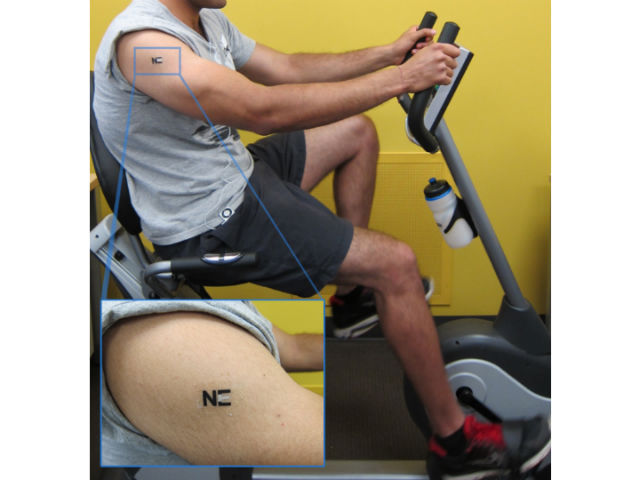
Most of the sweat is released during sports training, but scientists are already working to make the device suitable for everyday use.
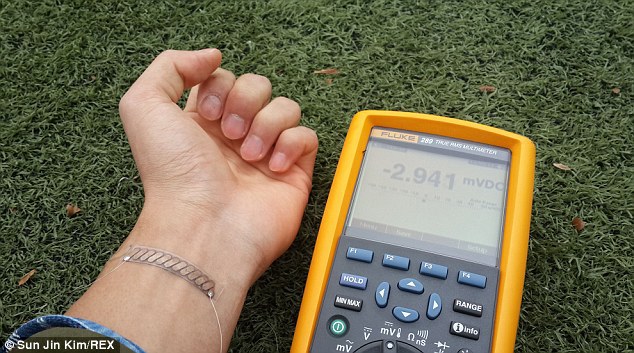
Another promising idea is to take advantage of the temperature difference between human skin and the environment. A difference of 0.5 ° C gives 40 milliwatts of electricity. Flexible and lightweight generator can be glued directly to the skin.
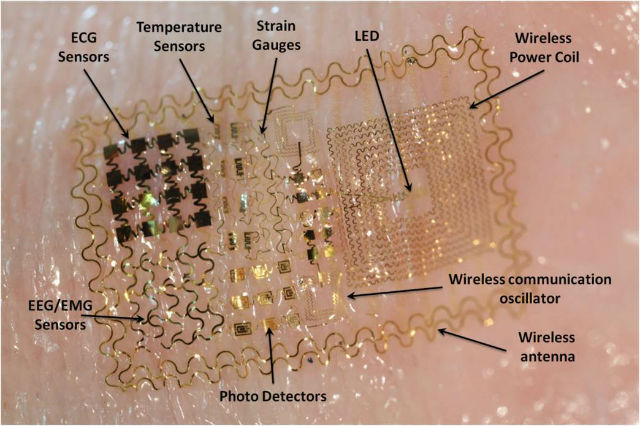
Production of all electronic components of the tattoo has already been put on stream .
A year ago, a device capable of reading brain currents was demonstrated at the AT & T Innovation Showcase and, based on their type, determine whether it is worthwhile to bother a person at the moment ( Source ). Agree it is much more convenient than in a hurry to turn off the sound on the phone and write to the non-current interlocutor “I'm sorry, I'm at a meeting, call back later.”
The idea of using the body as a peripheral device has long roused the minds of scientists. Magic Finger ( http://habrahabr.ru/post/155205/ ) attached to a finger turns any surface into a touch interface. The next step is to remove the incomprehensible piece of iron and allow the finger itself to work with the touch input. Electronic tattoo technology is the best help in this matter.

Motorola Moto X offers to use a digital tattoo to quickly and safely unlock a smartphone. Transferring new functions to human skin is a logical step to improve the functionality of interaction with gadgets.
Body display

At Indiegogo, Ritot collects money, projectors are watches that project a variety of information onto the back of the hand.
At the Massachusetts Institute of Technology, technologies are being developed that allow the entire skin to be transformed into a large “tactile display” ( Source ), thanks to which we will receive information through the skin, not just the eyes.
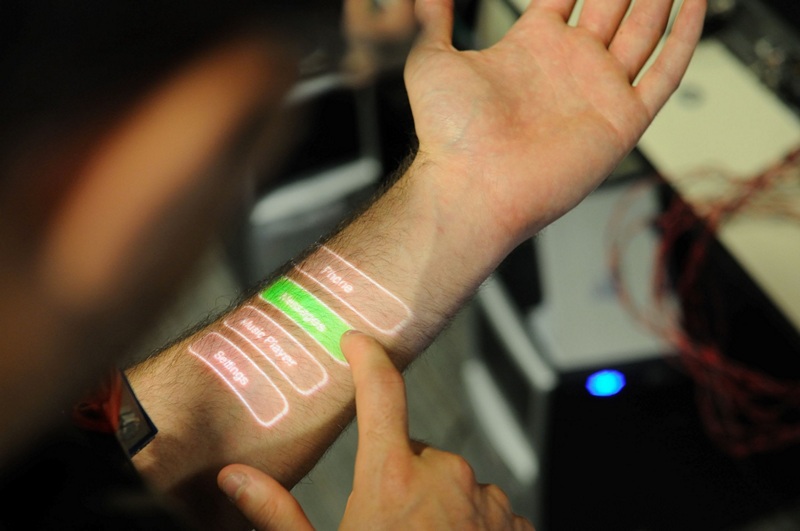
Jim Milk in the concept offers to bring the touch screen directly to the skin, and provide power through blood flow. A similar Skinput idea suggests a pico projector.
Next
Peculiar, but the traditional smartphone user interface can work on the human body. Traditional interactive implants can work not under the skin (which is associated with many unpredictable risks), but directly on the skin, using its natural features as a new peripheral device. With different types of vibrations, the skin can alert you to an incoming call, e-mail or SMS. Electronic tattoo with built-in speakers will answer calls. Projecting an image (or creating an image through a flexible display of an electronic tattoo) directly onto your hand will provide convenient access to the Internet.
The main thing is that for the benefits of new technologies, we can always see the possible risks, and in pursuit of unprecedented opportunities, we should not put ourselves in the corner of losing control over our own body and mind.
Source: https://habr.com/ru/post/235721/
All Articles